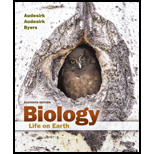
Concept explainers
The biological species concept is difficult or impossible to apply to
a. asexually reproducing organisms.
b. large organisms.
c. rapidly evolving organisms.
d. plants.
Introduction:
According to biologists, biological species are the group of populations, which can interbreed naturally and are reproductively isolated from different groups of the different populations. A species is different from another species due to genetic divergence and isolation. Individuals of a species share the same gene pool.
Answer to Problem 1MC
Correct answer:
The biological species concept is difficult or impossible to apply to asexually reproducing organisms.
Explanation of Solution
Explanation for the correct answer:
Option (a) is given that the biological species concept is difficult or impossible to apply to asexually reproducing organisms. The organisms, which reproduce asexually, usually clone themselves. Gene exchange does not occur in these organisms. Biological species concept works by using genetic information that is usually exchanged during sexual reproduction. Hence, option (a) is correct.
Explanation for incorrect answers:
Option (b) is given that the biological species concept is difficult or impossible to apply to large organisms. Large organisms usually reproduce sexually and exchange genes to the next generation. The gene flow helps the species concept to identify the species. So, it is an incorrect option.
Option (c) is given that the biological species concept is difficult or impossible to apply to rapidly evolving organisms. Evolution of organisms occurs due to genetic divergence. Biological species concept can identify the organisms by investigating the gene pool and gene flow among the species. So, it is an incorrect option.
Option (d) is given that the biological species concept is difficult or impossible to apply to plants. Some plants reproduce sexually and can be identified by species concept. Some plants reproduce by budding that is asexual. In this case, species concept will not work, but in the given option general plant is given. So, it is an incorrect option.
Hence, options (b), (c), and (d) are incorrect.
Therefore, it can be concluded that the biological species concept is difficult or impossible to apply to asexually reproducing organisms. Asexual reproduction does not involve gene exchange, which is the important requirement of species concept.
Want to see more full solutions like this?
Chapter 17 Solutions
Biology: Life on Earth (11th Edition)
- Molecular Biology Question Please help. Thank you Explain what is meant by the term “defective virus.” Explain how a defective virus is able to replicate.arrow_forwardMolecular Biology Explain why changing the codon GGG to GGA should not be harmful. Please help . Thank youarrow_forwardStage Percent Time in Hours Interphase .60 14.4 Prophase .20 4.8 Metaphase .10 2.4 Anaphase .06 1.44 Telophase .03 .72 Cytukinesis .01 .24 Can you summarize the results in the chart and explain which phases are faster and why the slower ones are slow?arrow_forward
- Can you circle a cell in the different stages of mitosis? 1.prophase 2.metaphase 3.anaphase 4.telophase 5.cytokinesisarrow_forwardWhich microbe does not live part of its lifecycle outside humans? A. Toxoplasma gondii B. Cytomegalovirus C. Francisella tularensis D. Plasmodium falciparum explain your answer thoroughly.arrow_forwardSelect all of the following that the ablation (knockout) or ectopoic expression (gain of function) of Hox can contribute to. Another set of wings in the fruit fly, duplication of fingernails, ectopic ears in mice, excess feathers in duck/quail chimeras, and homeosis of segment 2 to jaw in Hox2a mutantsarrow_forward
- Select all of the following that changes in the MC1R gene can lead to: Changes in spots/stripes in lizards, changes in coat coloration in mice, ectopic ear formation in Siberian hamsters, and red hair in humansarrow_forwardPleiotropic genes are genes that (blank) Cause a swapping of organs/structures, are the result of duplicated sets of chromosomes, never produce protein products, and have more than one purpose/functionarrow_forwardA loss of function mutation in Pitx1 enhancers can cause (blank) Removal of Pitx1 exons and growth of ectopic hindlimbs, growth of extra ectopic forelimbs, loss of forelimb specification and development, and loss of hindlimb specification and developmentarrow_forward
- Hox1a most likely contributes to (blank) patterning in the developing embryo? Ventral, posterior, limb or anteriorarrow_forwardSelect all of the following that can help establish Hox gene expression boundaries (things that affect Hox and not things that Hox affects). Retinoic acid, anterior/posterior axis, fibroblast growth factors, vagal neural crest, and enhancersarrow_forwardEctopic expression of Hox often results in (blank) phenotypes. (Blank) transformations are characterized by the replacement of one body part/structure with another. Hoxeotic, homealoneotic, joexotic, or homeoticarrow_forward
 Biology (MindTap Course List)BiologyISBN:9781337392938Author:Eldra Solomon, Charles Martin, Diana W. Martin, Linda R. BergPublisher:Cengage Learning
Biology (MindTap Course List)BiologyISBN:9781337392938Author:Eldra Solomon, Charles Martin, Diana W. Martin, Linda R. BergPublisher:Cengage Learning
 Biology: The Dynamic Science (MindTap Course List)BiologyISBN:9781305389892Author:Peter J. Russell, Paul E. Hertz, Beverly McMillanPublisher:Cengage Learning
Biology: The Dynamic Science (MindTap Course List)BiologyISBN:9781305389892Author:Peter J. Russell, Paul E. Hertz, Beverly McMillanPublisher:Cengage Learning Concepts of BiologyBiologyISBN:9781938168116Author:Samantha Fowler, Rebecca Roush, James WisePublisher:OpenStax College
Concepts of BiologyBiologyISBN:9781938168116Author:Samantha Fowler, Rebecca Roush, James WisePublisher:OpenStax College Human Biology (MindTap Course List)BiologyISBN:9781305112100Author:Cecie Starr, Beverly McMillanPublisher:Cengage Learning
Human Biology (MindTap Course List)BiologyISBN:9781305112100Author:Cecie Starr, Beverly McMillanPublisher:Cengage Learning Biology Today and Tomorrow without Physiology (Mi...BiologyISBN:9781305117396Author:Cecie Starr, Christine Evers, Lisa StarrPublisher:Cengage Learning
Biology Today and Tomorrow without Physiology (Mi...BiologyISBN:9781305117396Author:Cecie Starr, Christine Evers, Lisa StarrPublisher:Cengage Learning





